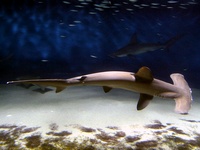
The nine known species of hammerhead range from 0.9 to 6 m long (3 to 20 feet). All the species have a projection on each side of the head that gives it a resemblance to a flattened hammer. The shark`s eyes and nostrils are at the tips of the extensions. The hammer shape of the head was once thought to act as a wing, aiding in close-quarters maneuverability and allowing the shark to execute sharp turns without loss of stability. However, it was found that the special design of its vertebra allowed it to make the turns correctly, more than its head. But as a wing the hammer would also provide lift; hammerheads are one of the most negatively buoyant of sharks. Like all sharks, hammerhead have electrolocation sensory pores called ampullae of Lorenzini. By distributing the receptors over a wider area, hammerheads can sweep for prey more effectively. These sharks have been able to detect an electrical signal of half a billionth of a volt. The hammer-shaped head also gives these sharks larger nasal tracts, increasing the chance of finding a particle in the water by at least 10 times as against the ability of other `classical` sharks. Wider spacing between sensory organs better enables an organisms to detect gradients and therefore the location of a gradient source such as food or a mate. The peculiar head of this shark can be thought of as analogous to the antennae of an insect. The hammerheads are aggressive predators, eating fish, rays, cephalopods, and crustaceans. They are found in warmer waters along coastlines and continental shelves. Hammerheads have disproportionately small mouths and seem to do a lot of bottom-hunting. They are also known to form schools during the day, sometimes in groups of over 100. In the evening, like other sharks, they become solitary hunters Reproduction in the hammerhead shark occurs once a year with each litter containing 20 to 40 pups. Hammerhead shark mating courtship is a violent affair. The male will bite the female until she acquiesces, allowing mating to occur. Unlike many other shark species, the hammerhead shark has internal fertilization which creates a safe environment for the sperm to unite with the egg. The embryo develops within the female inside a placenta and is fed through an umbilical cord, similar to mammals. The gestation period is 10 to 12 months. Once the pups are born the parents do not stay with them and they are left to fend for themselves. A world-record 1,280 pound (580 kg) pregnant female hammerhead shark was caught off Boca Grande, Florida on May 23, 2006. The shark was carrying 55 pups, which suggests scientists had previously underestimated the number of pups per gestation. In May 2007 scientists discovered that Hammerhead sharks can reproduce asexually through a rare method known as parthenogenesis, as they have the ability to fertilize their own eggs. At first the announcement was considered skeptically, due to the fact that a female shark can store sperm inside her for months, even years, but it was confirmed through DNA testing that the pup lacked any paternal DNA. This is the first documented case of any shark doing this.